A brief narrative of the valorous warrior-prince Hamvira Deva of Odisha's famous Suryavamsa Gajapati dynasty.
Hamvira Deva: The forgotten warrior-prince of Odisha
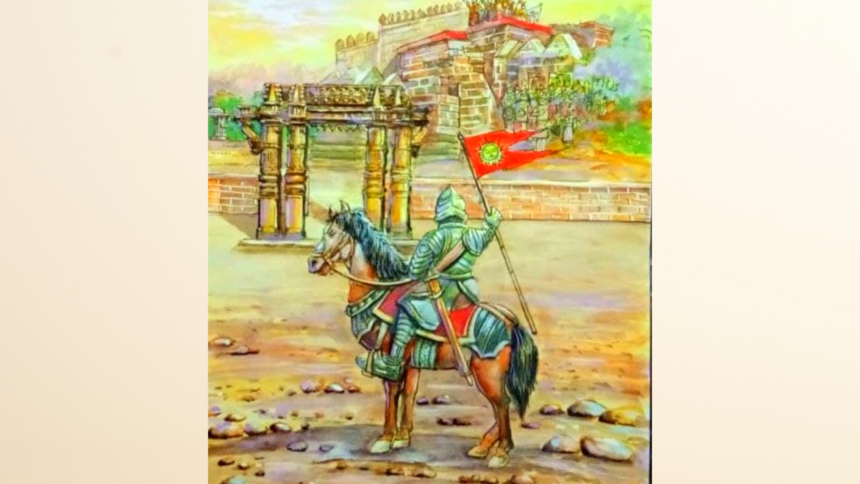
The political situation in Bharatavarsh in the medieval period
From the 12th century onwards, the Ghurids of Afghanistan, and later the Mamluks, conquered a large chunk of north India and established the Delhi Sultanate. Several minor Indian kingdoms had yielded to the Mamluks, while others resisted valiantly. The Eastern Ganga Kingdom of Kalinga, which ruled today’s Odisha, sections of southern Bengal, and northern Andhra Pradesh and had its capital in Cuttack, was among the latter. The dynasty produced a series of great monarchs, including Anangabhima III, Langula Narasinghadeva or Narasimhadeva I, and Bhanudeva II, who valiantly preserved Odisha’s sovereignty for nearly 200 years and were patrons of exquisite Kalingan temples.
During the time of Narasimhadeva I, the Ganga monarchs began to use the appellation Gajapati, possibly in acknowledgement of their army’s large elephant regiment. The great dominance of the Gangas, however, came to an end during the reign of Gajapati Bhanudeva IV, when his general Kapilendradeva Routray seized power. Kapilendradeva would go on to become one of mediaeval India’s greatest rulers, while his son Hamvira would be the architect who built his empire.
Down south, the Sangama brothers established the Vijayanagara kingdom in 1336 as a Hindu response to years of Sultanate control in South India and as a successor to the Hoysala monarchy. The Nayakas of Andhra-Telangana broke free from Sultanate rule, including the Reddi kingdoms of Rajahmundry and Kondavidu, the Recherlas Velamas of Devarkonda and Rachakonda, and others.
The Bahmani Sultanate, situated in Gulbarga, was to the north of Vijayanagara, and its rulers began as Governors of Deccan under the Delhi Sultanate before declaring independence. Similarly, in the 14th-15th centuries, the Sultanate governor of Malwa in present-day Madhya Pradesh declared his independence. Bengal’s Ilyas Shahi dynasty began as an independent kingdom in the 14th century.
The Gangas of Odisha often fought the Reddis, with border territories changing hands both ways. Gradually, the Gangas would come into conflict with Vijayanagara when they attacked the Reddis of Kondavidu, who were under Vijayanagara’s aegis. Moreover, the conflict was mostly about control of the fertile Godavari basin. The Vijayanagara empire and the Bahmani Sultanate were at war seeking control of the Tungabhadra region, allowing the Velamas of Telangana to act independently. Odisha’s western and northern borders were also under attack, with assaults from Malwa and Bengal, respectively.
The reign of Suryavamsi Gajapati Kapilendradeva
Kapilendradeva was the son of Jagesvara Routray, who according to the inscriptions of Raghudeva Mahapatra, was the son of a Nayaka of the Eastern Gangas. Described as a “possessor of elephants”, Jagesvara was an important military officer under the Ganga kings. So, it was natural for Kapilendradeva to follow his father into the Ganga army, where he rose to the rank of general.
The reign of the Suryavamsi Gajapatis began on June 29, 1435, when Kapilendradeva ascended to the throne. After crushing rebellions in Oddadi, Nandapura, Panchadharala, and Khimindi, Kapilendradeva successfully repelled attacks from Malwa and Bengal, as detailed in inscriptions bequeathed to posterity by the Gajapati’s Brahmin general Gopinath Mohapatra. Gopinath, a competent military commander, is considered to have led the Gajapati army during this expedition.
Following a debacle against Vijayanagara, Kapilendradeva dispatched Hamvira south to seize Rajahmundry (in Andhra Pradesh) and vassalize the Reddis. Raghudeva was appointed governor of Rajahmundry after it fell.
Hamvira next marched to Khambhammettu (modern Khammamet in Telangana), where, according to a Telugu catu poem, Gajavaru Tippa, one of Hamvira’s Velama leaders, earned his master’s favour by defeating the Yavanas led by Sanjar Khan. The Yavanas in this poem most likely relate to Bahmani Sultan Alauddin Shah II’s officers. According to the Burhan-i-Maasir, Sanjar Khan, a Bahmani officer, was reckless in crushing a Telangana Hindu leaders’ insurrection. Sanjar Khan had become quite notorious for his tyrannical ways when he began capturing civilians and selling them as slaves. The timely intervention by the forces of Hamvira provided respite to the local population. By 1453, Kondavidu in Andhra Pradesh was captured by the Gajapati forces.
Within a few years, a tense situation erupted in Telangana’s Bahmani-controlled territory. In 1457 AD, Sultan Alauddin Shah II died. Humayun Shah, his son, ascended to the Bahmani throne and nominated his favourites to high-ranking offices. When Malik Shah took over as governor of Telangana, Sikandar Shah, the Bahmani officer in command of the state, was disappointed. He left the court, went to Nalgonda to join his father, Jalal Khan, and raised the flag of rebellion against the Sultan. Humayun dispatched forces against Nalgonda under the command of Khan-i-Jahan, the governor of Berar. However, Khan-i-Jahan was soundly defeated by Sikandar, who appears to have had the help of a similarly disgruntled Hindu Velama chieftain of Devarakonda, Madaya Linga or Linga III.
Upon hearing the news of his defeat, Humayun Shah led a large force against Sikandar. The battle seemed to weigh in favour of the rebel forces until the elephant of the Bahmani Sultan performed a good manoeuvre and killed Sikandar. Humayun then besieged the fortress and within a week Jalal Khan submitted to the Sultan.
Battle at Devarakonda
But the Bahmani Sultan wasn’t done. He wished to crush every rebel chief in his land. He would not stop repressing rebellions until Linga, who had backed Sikandar and Jalal, was brought to his knees. While marching to Warangal, Humayun dispatched his officers Khwaja-i-Jahan and Nizam-ul-Mulk with a massive army of 20,000 cavalry, 40 elephants, and a prodigious infantry against Devarakonda. When Madaya Linga realised he was outnumbered, he took refuge in the Devarakonda fort. The Bahmani army was massive, and the Velamas’ time was running out.
Linga realised that the only competent person nearby who would sympathise with his plight and assist him was the Elephant King and the Deputy of Prabhu Jagannath – Gajapati Kapilendradeva of Odisha. Without wasting any time, Linga asked Kapilendradeva for help. Kapilendradeva dispatched an army under the command of Hamvira. The combined forces of Odisha and Devarakonda hammered the Bahmani troops, who soon had to retreat.
Syed Ali Tabataba, the chronicler, describes the battle briefly in his Burhan-i-Ma’asir:
“The king of Orissa from greed of gain and for the defence of paganism, thought himself bound to assist the infidels of that fortress; so, he sent a countless force with a hundred elephants to the assistance of the defenders of the fortress (of Devarakonda). The Bahmani commander learnt in time of the advance of the Orissan army, but before he could extricate his troops from their unfavourable position, the Orissan army came upon them and the Velamas also sallied out from the fort. Caught between the two forces, the Bahmani army was routed, and the whole of their baggage, elephants and horses looted. The Musulmans were pursued to a distance of 3 jarsakhs; nearly six or seven thousand of their cavalry were killed, and a great number, besides, died of thirst in the deserts.”
Historian HK Sherwani writes of the Devarakonda drubbing:
“The rout at Devarakonda must have negatively enhanced Mahmud Gawan’s estimation in the eyes of the king. While he had been successful in quelling two major rebellions of those who wanted to dethrone Ahmad II and Humayun, the solitary expedition against a confederation of Telugu Rayas undertaken by Khwaja-i-Jahan had proved to be a failure…”
This battle of Devarakonda is reported to have occurred in 1458. Following the battle, Linga became a vassal of Kapilendradeva, and Kapilendradeva took the title Kalabargeswara (Lord of Kalaburagi or Gulbarga region).

Hamvira wins the Warangal fort
Humayun Shah was taken aback by the surprise defeat, but he needed to return to his capital to put down another rebellion. He left Telangana in the hands of Mahmud Gawan, who was stationed in Warangal. With the Sultanate in disarray, Hamvira realized it was time to launch an attack on Warangal. As Gawan fled from the assault of the formidable Gajapati army, Hamvira easily overcame the Bahmani garrison in the Warangal fort, leaving the fort and everything inside it for Hamvira’s forces. The Gajapati army’s success basically lied with the massive infantry troops and heavy elephantry.
Two sets of inscriptions unearthed on the Eastern and Western gates of the Warangal fort in Telangana mention the capture of the fort from the hands of the Bahmani Sultan by the great Suryavamsa king – Gajapati Kapilendradeva of Odisha. The eastern gate’s inscription credits Kumara Hamviradeva Mahapatra, the eldest son of Maharaja Kapilendradeva, with capturing the fort, while the other inscription hails Hamvira’s cousin and Kapilendradeva’s nephew Raghudeva Narendra Mahapatra for routing the enemy forces at Warangal. According to historian DC Sircar, it is possible that Hamvira led the army and Raghudeva was his deputy.
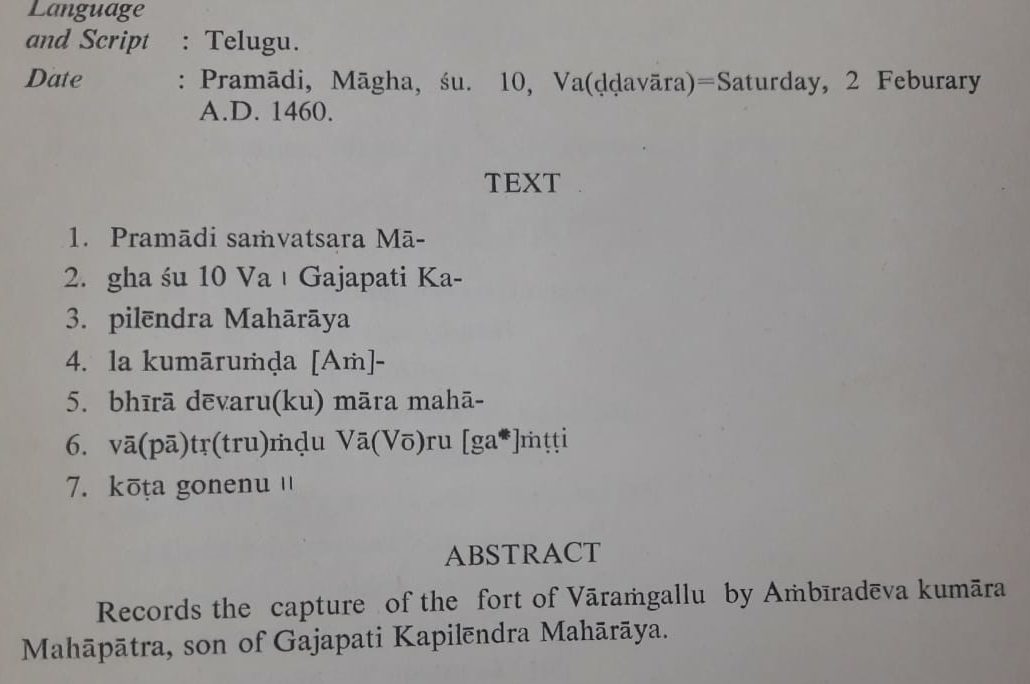
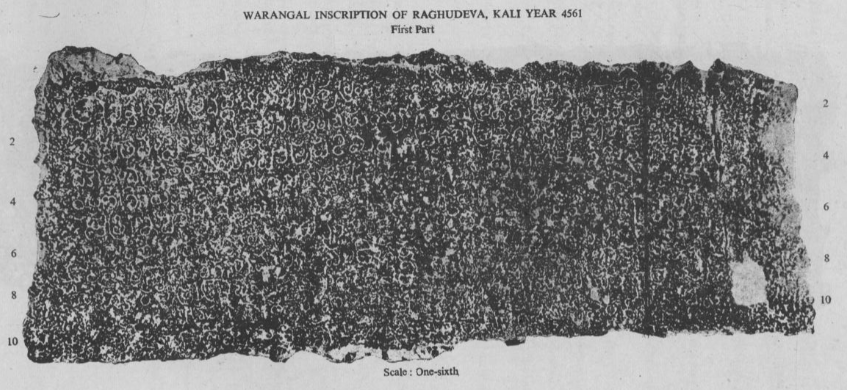
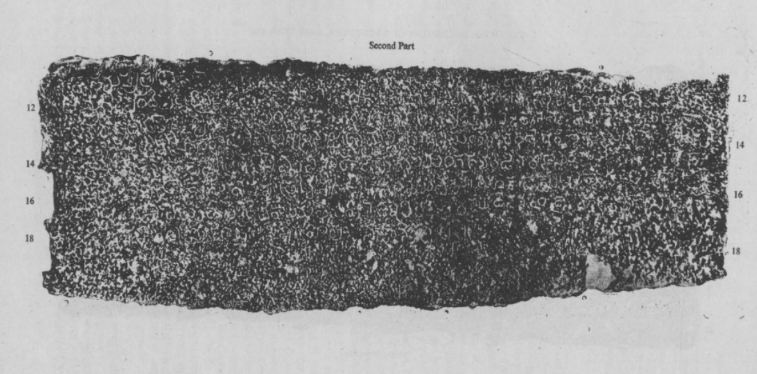
Both inscriptions are dated February 2nd, 1460 AD (Kali year 4561, Pramathin, Magha Su 10, Mrgasira, Brhavasara). According to historian R. Subrahmanyam, the siege of the fort would have ended on February 2nd, 1460.
The Warangal fort had been built by the rulers of the Kakatiya dynasty. The Velama kings of Devarakonda and Rachakonda were successors of the Kakatiya dynasty in Telangana, among other kings. The Recherla Nayakas, as they were called, had their base at Rachakonda (in present-day Yadadri Bhuvanagiri district of Telangana) and controlled the Warangal fort. In the 15th century, Warangal fell into the hands of the Bahmani Sultanate. The Velamas’ rebellion provided Hamvira with the ideal opportunity to wrest it from the hands of the Bahmanis and turn the Recherlas into his allies, allies who would assist him in any future campaign against the Bahmanis.
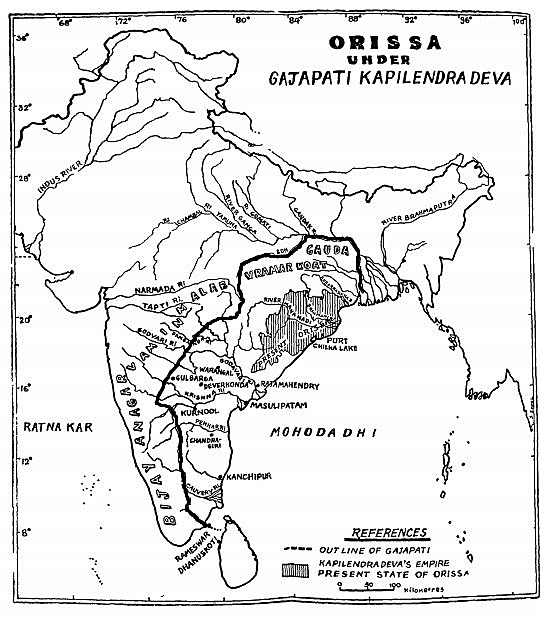
Later life of Hamviradeva
The Gajapati army, along with the Velamas, raided the Bahmani capital Bidar (then called Bedadakotta) twice in the 1460s. Hamvira advanced against Vijayanagara and captured the kingdom’s southern regions. By 1464, the Gajapati’s writ ran from Udayagiri in Andhra Pradesh to parts of Tamil Nadu all the way up to Rameshwaram.
According to an inscription at Munnur, Tamil Nadu, Hamvira’s son Dakshina Kapilesvara Hamvira Kumara Mahapatra ruled the territory. Hamvira is reported to have cleaned his blood-stained sword in the waters of the southern sea after defeating the Vijayanagara emperor.
Copper plates of Ciruvroli grant made by Hamvira mention his valour and valour. According to the grant, he gave villages to Brahmins who resided on the banks of the Krishna River. The inscription refers to one of the villages named after the prince as Hamvirakumara Satpura or Hamvirapura.
In the annals of Odia history, the last half of Hamvira’s life is shrouded in mystery. According to Ferishtah and Syed Tabataba’s accounts, Hamvira revolted because he was disgruntled with his father Kapilendradeva’s decision to appoint Hamvira’s brother Purushottamadeva as the heir. The Bahmanis took advantage of the civil war and offered him the position of vassal at Kondapalli (Andhra Pradesh), which he accepted. However, by 1484, he had made peace with his brother and had switched to his side. Another theory holds that Hamvira took over all of his father’s southern lands, prompting Kapilendradeva to crown Purushottamadeva. However, much of the history is unclear, and the discovery of additional epigraphic and literary material should provide an accurate timeline of events.
Such is the saga of the forgotten warrior-prince of Odisha.

Leave a Reply